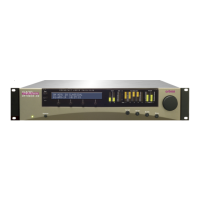1-22
INTRODUCTION ORBAN MODEL 9400
to prevent overloading or overmodulation of the transmission system. This peak
overload level is defined differently, system to system.
In FM modulation, it is the maximum-permitted RF carrier frequency deviation. In
AM modulation, it is negative carrier pinch-off. In analog telephone / post / PTT
transmission, it is the level above which serious crosstalk into other channels occurs,
or the level at which the amplifiers in the channel overload. In digital, it is the larg-
est possible digital word.
For metering, the transmission engineer uses an oscilloscope, absolute peak-sensing
meter, calibrated peak-sensing LED indicator, or a modulation meter. A modulation
meter usually has two components — a semi-peak reading meter (like a PPM), and a
peak-indicating light, which is calibrated to turn on whenever the instantaneous
peak modulation exceeds the overmodulation threshold.
Line-Up Facilities
Metering of Levels
The meters on the 9400 show left/right input levels and output modulation.
The output meters can be switched to read the left/right digital process-
ing chain output signal, the gain reductions of the left and right look-
ahead limiters in the digital processing chain, or the analog processing
chain output signal. In the latter case, the left-hand meter reads negative
peaks of the higher of the two stereo channels and the right-hand meter
reads the higher of the positive peaks.
Left and right input level is shown on a VU-type scale 0 to –40dB), while the meter-
ing indicates absolute instantaneous peak (much faster than a standard PPM or VU
meter). The input meter is scaled so that 0 dB corresponds to the absolute maximum
peak level that the 9400 can accept. If you are using the AES3 digital input, the
maximum digital word at the input corresponds to the 0 dB point on the 9400’s in-
put meter.
Built-in Calibrated Line-up Tones
T
o facilitate matching the output level of the 9400 to the transmission system that it
is driving, the 9400 contains an adjustable test tone oscillator that produces sine,
square, or triangle waves at 9400’s (analog or digital) left and right outputs. The
frequency and modulation level of the line-up tones can be adjusted from the front
panel (as described in Test Modes on page 3-54).
Y
ou can adjust the frequency and modulation level of the built-in line-up tone. You
can use the front panel, the PC Control software, or the opto-isolated remote con-
trol interface ports to activate the Test Tone.
Built-in Calibrated Bypass Test Mode
A BYP
ASS Test Mode is available to transparently pass line-up tones generated ear-
lier in the system. It will also pass program material, providing no gain reduction or

